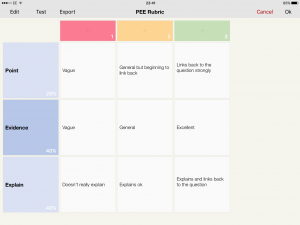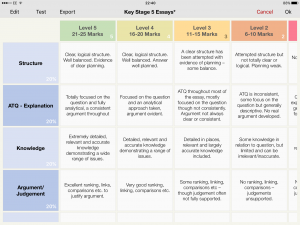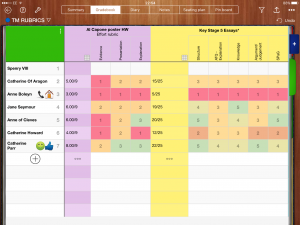*This blog has been written to my first ever TeachMeet presentation at Rushey Mead Academy, Leicester. If you have never been to a TeachMeet go to one!*
Unfortunately for you, I love to twist a quote or a movie/song title to fit my own agenda. This blog post will outline the use of Rubrics on iDoceo. It will give you links and a quick overview of how to use Rubrics on iDoceo with a little help from an Australian.
Now, those of you who know me know I am GLUED to my iPad and iDoceo is a godsend (it is only available on an iPad though – I will be offering an alternative rubrics app for Android users so bear with me). iDoceo is a handy assessment tool which allows you to import classes from excel spreadsheets and export them just as easily, it generates a seating plan which you can easily edit and add photos to with its facial recognition technology – meaning all you need do is attach your class photos from SIMS to an email, attach it to iDoceo and then drag each individual childs face to a designated student, it allows you to create assessment folders, attach all of your class plans and resources to each class, annotate individual students with colours, symbols and attach photographs of work or effort (or lack of), allows you to generate different seating plans for different classrooms, and a whole host of other cool features to make your life as a teacher easier!
Its latest feature is rubrics and for those of you have no idea what I am talking about, a rubric is essentially a scoring guide used to evaluate the quality of students’ work. It 99% of the time set out like a table and can be simple like this:

or be more detailed like this (excuse it being cut off, I could not fit the whole rubric in):

Now these are easy to make. You can weight individual skills with different percentages, you choose whether the rubrics generates an average score, an additional score (adding the marks from up from each skill), or a percentage score. As you can see here from my example:

Often the assumption is that rubrics are useful for peer and self assessment, but I want to argue here that it is easy to incorporate them into your practice, especially when they are digitally accessibly via iDoceo or the Android alternatives. They make marking easier and feedback even easier knowing exactly what your students need to do push on to the next level.
You can also easily upload pre-made rubrics which I advise you to make on Excel and save them as CSV files. This is because PDF and XLS features are still buggy and having spoken to the developer briefly, they are working on it for the next update of iDoceo.
iDoceo is currently £8.99 which is a steal considering what it does. You can literally save your teaching life to it including your own timetable and schedule and it sinks perfectly with Apple Calendar. It allows you to generate and save an unlimited amount of rubrics which help you with your marking, you can print progress reports, you can email parents these scores directly from iDoceo and it is a god send! However, those of you who do not use iDoceo, there is an app for Android users which allows you to generate 10 different rubrics and and keep class lists in the same manner as iDoceo for rubrics based marking. It is called Rubric Scorer – this is free version for you to try out and this is Rubric Scorer Pro which is £2.99. I have not played with these Android versions but the reviews are positive and a good alternative if you have not got an iPad.
Here I will list a bank of resources for you to look at which are useful to find pre-made rubrics and for generating for your own:
https://www.youtube.com/watch?v=xHdfahcJI2Q – This is our handy Australian friend who has saved me from making a video about how to create rubrics on iDoceo.
http://fulltext.study/preview/pdf/352566.pdf – This a very nice academic piece outlining why clear learning objectives are not enough and why rubrics are incredibly useful
http://ctlrdc.ca/curriculum/assessment/rubrics/ – This article outlines some very good pros and cons.
https://medium.com/peergrade-io/tips-and-tricks-for-creating-a-perfect-rubric-7b710492b682#.adnr4n5jr – How to be clear and consistent with your rubrics
http://www.cultofpedagogy.com/holistic-analytic-single-point-rubrics/?utm_content=buffer85399&utm_medium=social&utm_source=twitter.com&utm_campaign=buffer – This handily outlines the different types of rubrics and their uses and pros/cons
http://www.teacherplanet.com/rubrics-for-teachers – A variety of pre-made rubrics
http://teacher.scholastic.com/tools/rubric.htm – Free rubrics generator
http://www.rcampus.com/indexrubric.cfm – A catalogue and a generator
http://rubistar.4teachers.org/index.php – A catalogue and a generator
